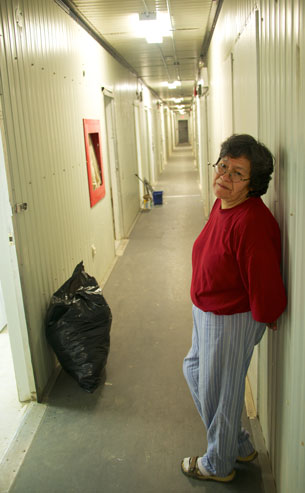
Housing in Attawapiskat remains a problem

Richard Spence reporting in Attawapiskat
ATTAWAPISKAT - Monique Sutherland’s first day as Attawapiskat’s housing manager was in June of 2008. She says she received no special training, the files were scattered, she had no staff and not long after she started the community was forced to declare a housing crisis after a catastrophic sewage backup left many homeless. Despite the turmoil, Sutherland says, she has persevered in the post longer than her predecessors, established a more efficient record keeping system and oversees a staff of tradespeople but still cannot meet demands. She says, the 2009 back up was the tipping point but the roots of the housing crisis grow deeper and at current rates it will be years until needs are met, “We keep on it but it could ten or fifteen years.”
Attawapiskat Housing Crisis Deep Roots
Attawapiskat would have to evacuate again in 2013 after spring floods damaged many homes including the temporary residences of Nurses and Teachers working in the community. An anonymous source at the hospital says lack of available housing has created a critical shortage of permanent nurses and emergency relief staff who come to the community on short-term contracts have been have been forced by circumstance to sleep on the ward in beds typically occupied by the patients they care for.
Sutherland says band members struck by the shortage have options but wait lists are long and space is limited. “A lot of people end up having to go to relatives houses which are already overcrowded. If they can’t they go to the homeless shelter but it’s full so they have to put up tent frames.” She also has advice for off-reserve band members with thoughts about returning home, “Stay where you are. You’re welcome to visit, but as it sits we have no houses available.”

Denise Okimaw is a resident of the emergency shelter trailer complex on the Eastern edge of Attawapiskat First Nation
Denise Okimaw is a resident of the emergency shelter trailer complex on the Eastern edge of Attawapiskat First Nation. She says, she pays almost five hundred dollars a month to share a single room with her teenage son and has lived here for the last four years. Most days, she wakes early, eats breakfast then fills a mop bucket and cleans the kitchen and bathroom common areas she shares with more than 50 neighbours. She used to be paid for this work but recent cutbacks led to her lay-off
The kitchen is a barren linoleum floor between empty counter tops and cupboards near the main entrance. There are no plates, no cups, no tables, no chairs, the sink has no drainpipe and the oven is missing parts of its door. The washrooms, laundry room and shower facility have puddles of water leaked onto the floor. “The security guards are supposed to keep it clean but they don’t maintain it and the smell of the toilets is overpowering,” says Okimaw, as she sprays done the fixtures in the women’s pubic washroom and wipes at the surface with a blue and white rag.
Before her room in the shelter, Okimaw spent nights in Attawapiskat community hotels, the Healing Lodge outside of town and emergency housing in Cochrane, Ontario. She says she was evacuated after the 2009 sewage back up rendered her house uninhabitable. Her former home is a four bedroom white house near the river that now has a padlock on the front door. The house has not been renovated since the back up and is now used for storage while she stays at the homeless shelter wondering what’s being done to fix it.
Sutherland says she hears stories like Denise’s everyday and wishes there was more she could do. She also says, her own housing situation is less than ideal. At time of writing, she shares a trailer with her son but not long ago they lived in a shack with minimal insulation, “some nights in the winter it would be so cold. I would be under five blankets and still wake up in the night freezing. My son would build a fire even at five in the morning.”
Sutherland says, the housing budget is depleted because some band members in new houses have refused to pay their rent and many old houses are in need of extensive and expensive repairs. “Some of the houses are about to collapse. They need to be fixed but we don’t have money to buy supplies.”
A new program called RRAP (Rehabilitation Repairs Application Program) has provided some support for houses in need of renovation but the funding is scheduled to expire at the end of October. She also says, Attawapiskat’s funding application to build new houses through the CMHC (Canadian Mortgage and Housing Corporation) was denied when Aboriginal Affairs and Northern Development Canada (AANDC) refused to guarantee a loan due to accounting inadequacies and a budget deficit. “We used to build 10, maybe 15 houses some years. No we aren’t able to meet the needs.”
David Chookomoolin is an addictions counselor, heavy metal music enthusiast, and one of many names on the waiting list for a house.
He says, as a single person he is not a high priority so he has no choice but to pay four hundred dollars a month for a small room in a crowded house. He says he’s been on the waiting list for years but can’t seem to get any closer to his own place. “Last time I checked I was around number 400 or something.” Chookomoolin says he’s been renting rooms for 10 years and can’t see a change in situation anytime soon.
Janie Kataquapit is a colleague of David’s who recently returned home to Attawapiskat after years spent living in the United States. She and her two sons moved in with her elderly parents. The three-room house has one bathroom and a basement still in need of repair after the 2009 sewer back up. Her parents decided to move into a tent frame in the yard to allow Janie’s family more room. With winter approaching, Janie worried her parents would freeze in the canvas roofed structure. “I wasn’t sure if I was going to be able to stay in the community. This is my home but my Parents couldn’t live out there in the freezing weather.” She has now found a place to stay, but many of her clients struggle to find adequate housing, “it’s tough to help someone fix a problem you experience yourself.”
Wayne Turner is Attawapiskat’s Executive Director. He lives on the second floor of the Tony Fireman Healing Lodge outside of town. The former addictions treatment center has been appropriated as emergency housing and the main level is full of elders, children and families with no other place to stay. He says housing the displaced is a major drain on band funds, “we receive no additional funds for transitional housing. The money all comes from the Band’s discretionary fund.” He says, the biggest cost is the hydroelectric bills, which range from twelve to fifteen thousand dollars a month for the all-electric facilities.
“Keep in mind it’s a construction trailer. It’s not suitable permanent housing for people and families. Unfortunately temporary has a way of becoming permanent.” He says the Chief and Council have developed a multi-year housing strategy funded by 2.2 million dollars for new home builds provided by the Federal government. The end goal is to continually build new houses every year and end the need for emergency transitional shelters. “The Band has already started building. These are the new houses on the West side of town. The houses are assessed a market value rent and the First Nation backs the mortgage.”
He says, people who live in these houses can eventually own the building if they maintain it but due to provisions of various sections of the Indian Act they cannot use the homes to establish equity. He says this is one of the biggest issues facing residents. “What other part of the country can you not leverage what you own into advantages for yourself? The only difference here is that there is an invisible line and if you are on one side of it you are treated differently.” To other side of the line belongs to the Province of Ontario. A special land use permit is required to build there. Inside the Reserve prospective homebuilders must be allotted a plot of land by the band.
Chief Theresa Spence lives in a yellow bungalow that was once a police station down a back alley near the hospital. Her front door opens to a chain-link and black canvas fence at the perimeter of a current contamination remediation site. On her walk to work, she takes a left, follows the fence-line along a hard-packed grit road frequented by heavy-duty equipment carrying contaminated soil to containment tanks on the outskirts of the First Nation and water trucks who spray the road to keep the dust plumes down. She then takes another left at the only sidewalk in Attawapiskat, four one-meter square slabs of concrete connecting the steel grate steps of the mural emblazoned Band office to the wooden entryway of a graffiti adorned decommissioned post-office.
Chief Spence says, present legislation excludes First Nations people from participation in the National economy. “I’ve heard from a few people their mortgage was denied because they live on Reserve. It shouldn’t be that way. If you have a good job and have shown yourself responsible you should be able to have you dream-house built.” Spence says, the housing budget is a major drain on the band budget and the band has no recourse to draw an income for new projects. “We can’t tax people, there are many unemployed. If we want to do any project we have to beg the Federal Government and that dependency doesn’t solve the problem.”

There is new housing being built in Attawapiskat
Paul Kataquapit is part of a four-person carpentry crew building a house next to his brother’s diner in a central section of town. He spent his own money to have building materials freighted to Attawapiskat on the barge because he was, “tired of waiting for the Band to approve the lot and Indian Affairs (AANDC) to pay for the building.” The frame has gone up quickly but says he worries the supplies he needs for the roof will make it before the snow starts to fall. He says while he waits to hear from government his niece and her family had to live in a crowded house and it was clear to him that, “no one is going to do this for us. We needed to take action ourselves.
Richard Spence
 This story produced with guidance from Danny Kresnyak of Journalists for Human Rights as part of JHR’s Northern Ontario Initiative.
This story produced with guidance from Danny Kresnyak of Journalists for Human Rights as part of JHR’s Northern Ontario Initiative.
Related articles
The Article Room in a Crisis: Housing in Attawapiskat by Richard Spence first appeared on NetNewsledger.com - News at the Speed of the Internet ©






